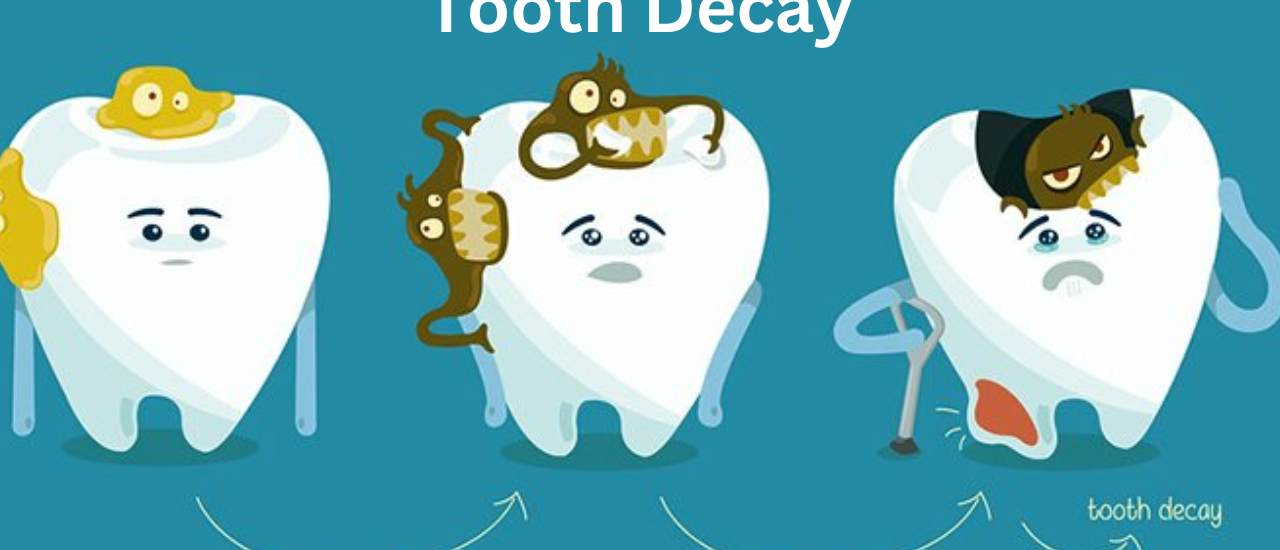


Cavities are little holes or openings in the hard surface of your teeth that are permanently damaged. Cavities, also known as tooth decay or caries, are brought on by a number of things, including oral bacteria, frequent eating, consuming sugary beverages, and inadequate tooth cleaning. When plaque that accumulates on your teeth produces acid, tooth decay may result. Although children are more likely to develop cavities, adults can also have them due to changes brought on by ageing. Plaque can get into contact with tooth roots when there is receding gum tissue and a rise in gum disease. Cavities can affect everyone who has teeth, even young children. If left untreated, cavities get larger and harm your teeth’s inner structure. They may result in tooth loss, an infection, and extreme tooth pain.
Your teeth are covered in a transparent, sticky film called plaque. It results from eating a lot of carbohydrates and starches and neglecting to properly brush your teeth. When carbohydrates and sugars aren’t removed from your teeth, bacteria start to feed on them and plaque is soon formed. The bacteria and acid that cause tooth decay keep migrating along the inner tooth material, which is home to nerves and blood vessels, as tooth decay progresses. The bacteria causes swelling and irritation of the pulp. More minerals are lost if the tooth decay process is allowed to continue. The enamel weakens and breaks down with time, creating a cavity. In your tooth, a cavity is a hole. A filling is required by a dentist to fix the lasting damage.
Cavities are little holes or openings in the hard surface of your teeth that are permanently damaged. Cavities, also known as tooth decay or caries, are brought on by a number of things, such as oral bacteria, frequent eating, consuming sugary beverages, and inadequate tooth cleaning.
Plaque, a sticky film formed by bacteria over your teeth, is the primary cause of tooth decay. Over time, this results in surface damage to your teeth. Children frequently have tooth decay, so it’s crucial to ensure that they start taking care of their teeth and gums at a young age.
If left untreated, cavities get larger and harm your teeth’s deeper layers. They may result in tooth loss, an infection, and excruciating dental pain. Your best defense against cavities and tooth decay is regular dental appointments and good brushing and flossing practices.
It results from eating a lot of carbohydrates and starches and neglecting to properly brush your teeth. When carbohydrates and sugars aren’t removed from your teeth, bacteria start to feed on them and plaque is soon formed. Tartar is created when plaque that remains on your teeth hardens beneath or above your gum line.
Your teeth’s enamel is the tissue that consists their outer layer. The toughest tissue in your body, enamel is mainly comprised of minerals. The enamel starts to lose these elements as a tooth is exposed to the acids made by dental plaque. You can see a white spot growing on one of your teeth when this happens. The loss of minerals in this area is the first indication of tooth decay.
Enamel will weaken even more if tooth decay is allowed to continue. It’s possible that a white spot on a tooth turns brownish. Cavities, also known as dental cavities, or microscopic holes in your teeth, can develop as enamel weakens. Dentist will need to fix any cavities.
Additionally, the dentin contains tubes that connect to the tooth’s nerves. The tissue under the enamel is called dentin. Because of this, you could start to feel sensitive when dentin is impacted by tooth decay. This may be most noticeable when consuming hot or cold food or beverages.
The pulp is the tooth’s deepest layer. It houses the blood vessels and nerves necessary to maintain the tooth’s health. The pulp may get inflamed and begin to swell if it sustains damage. The surrounding tissues in the tooth may put pressure on the nerves because they are unable to enlarge to accommodate the swelling. Pain may result from this.
Abscesses in the teeth can cause excruciating discomfort that may spread to the jaw. Other symptoms that could be present include fever, swollen lymph nodes in your neck, and swelling of the gums, face, or jaw. A tooth abscess has to be treated right away because it might cause the infection to spread to your jawbone and other parts of your head and neck.
Not caring for your teeth and consuming an excessive amount of sugary or starchy meals and beverages are the main risk factors for tooth decay. Some individuals are more susceptible to tooth decay, especially those who:
You can take the following actions to stop tooth decay:
Cavities can be prevented and reversed by brushing your teeth with a high fluoride toothpaste at least twice daily and flossing once per day.
A spoonful of coconut oil is swished around the mouth for roughly 20 minutes, and then it is spit out.
After meals, chewing gum decreased bacteria levels that harm enamel. A stronger enamel that is better able to handle dental plaque may result from having less of these microorganisms.
To prevent tooth decay, take foods high in vitamin D, like dairy products. Dental cavities can be avoided with the aid of vitamin D.
Pain relief is achieved by rubbing clove oil on the affected area two to three times daily. Clove oil can help prevent cavities since it has anti-inflammatory and antibacterial properties.
5 Common Teeth Problems And How To Avoid It
Plaque & Tartar Buildup On Teeth And How We Can Remove This At Home?